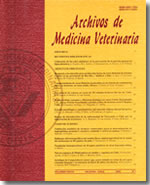Differences in muscle enzyme profile and metabolic response to fighting in bulls from one to three years old
Main Article Content
Abstract
The metabolic response to exercise is partially linked to muscle enzyme profile, and both factors might be influenced by ageing. This research aims: 1) To analyze the differences in muscle characteristics of fighting bulls of different ages; and 2) To assess whether the muscle enzyme profile is affected by ageing in the same way it affects other bovine breeds. Muscle biopsies from gluteus medius and semitendinosus muscles were withdrawn immediately after bullfighting, at depths of 3 and 5 cm, from a total of 24 animals, belonging to three age groups: A (1-year-olds; n=6), B (2-year-olds; n=6) and C (3-year-olds; n=12). Muscle concentrations of glycogen, lactate, adenosin triphosphate and glucose-6-P were determined. In addition, activities of citrate synthase, 3-OH-acyl-dehydrogenase, glycogen phosphorylase, lactate dehydrogenase and hexokinase were measured. No significant differences were found between the two analyzed muscles and neither between depths for any of the muscle parameters. Group A showed lower muscle lactate accumulation, with positive correlations between oxidative and glycolytic enzymes, reflecting a balance between both metabolic pathways. Group B was the most oxidative, whereas group C was the most glycolytic. Therefore, muscle oxidative potential achieved its maximum at 2 years of age, whereas the glycolytic capacity increased progressively with ageing. These results are different from those showed by other bovine breeds, with a progressive reduction in oxidative potential from birth. In conclusion, age significantly influences metabolic response to fighting as well as muscle enzyme profile in bulls.

